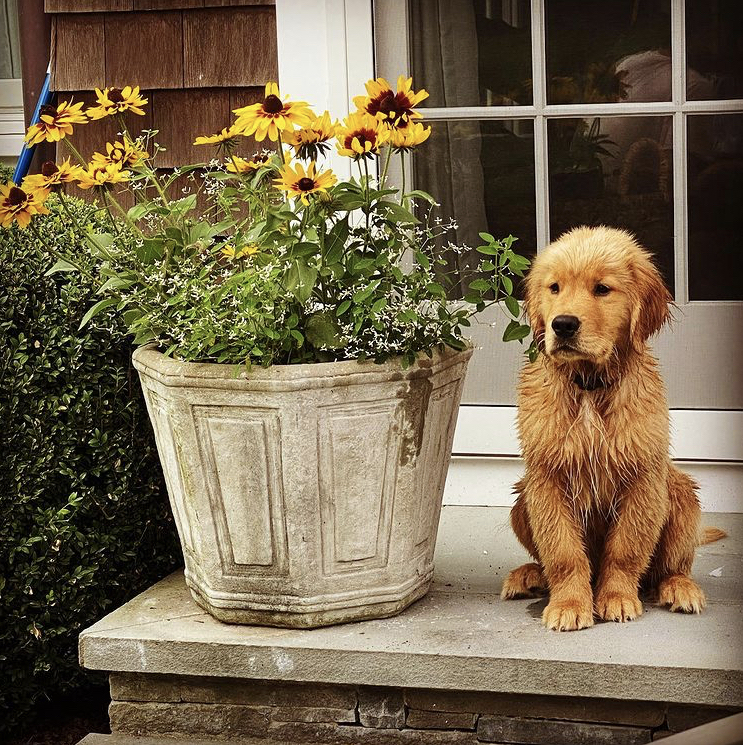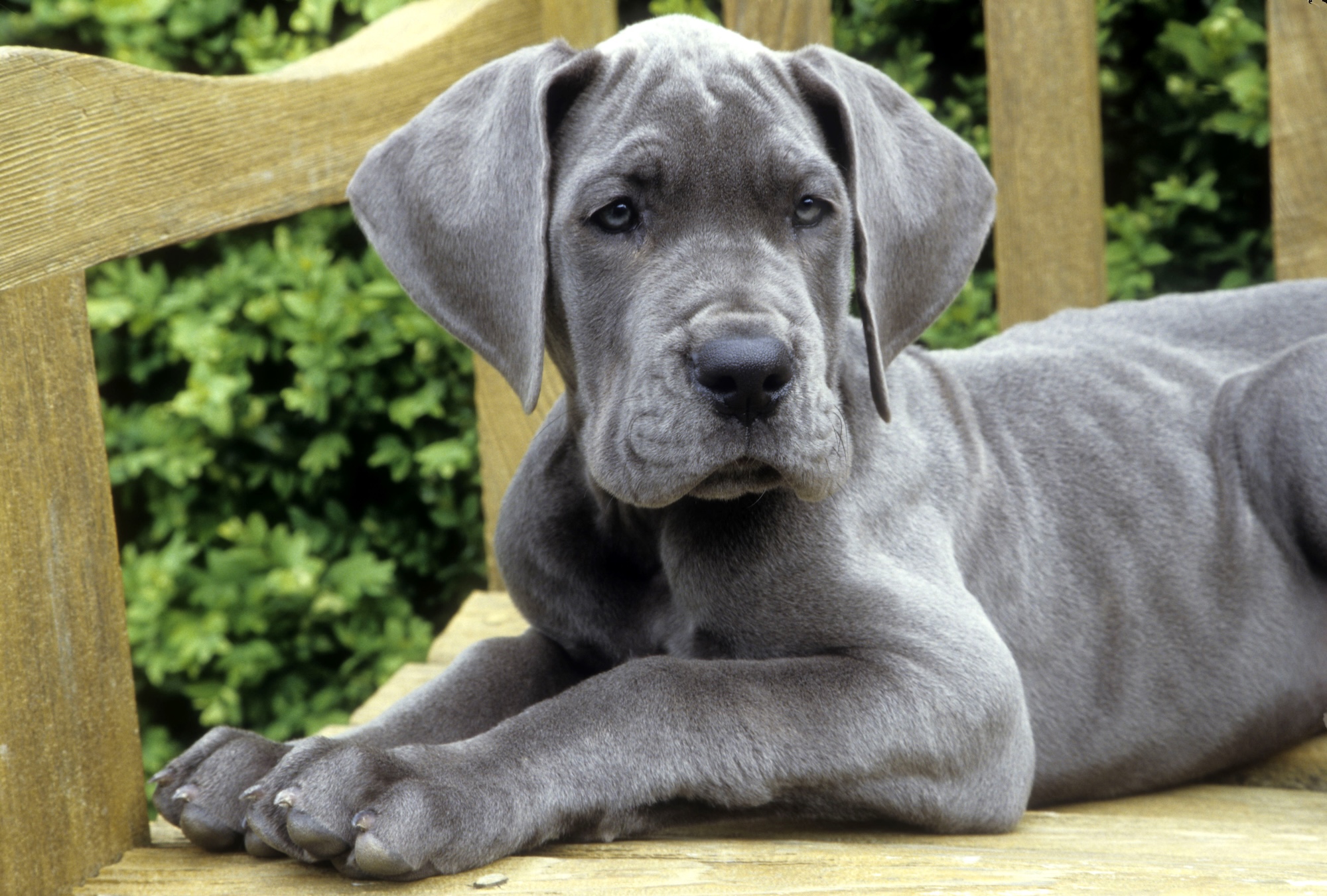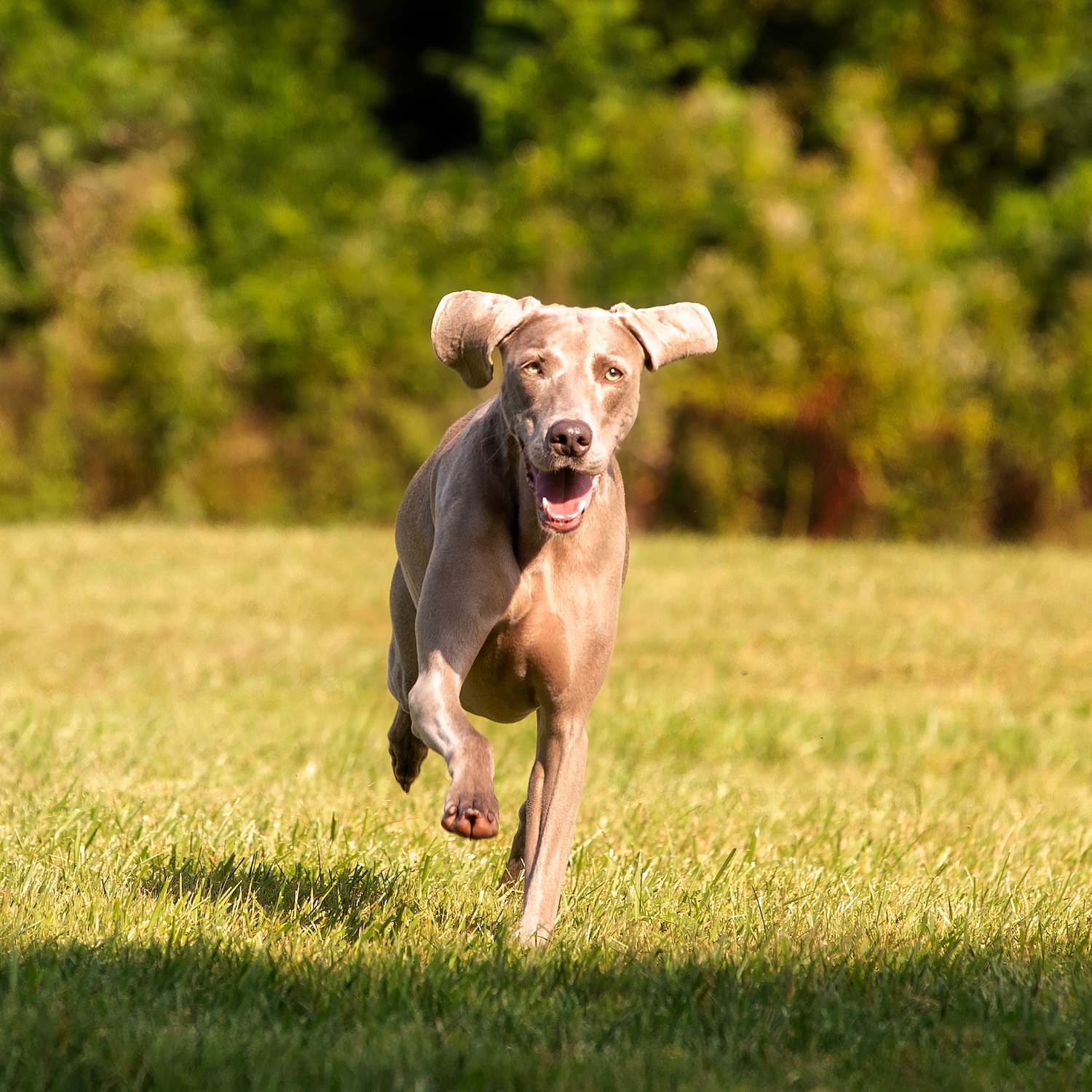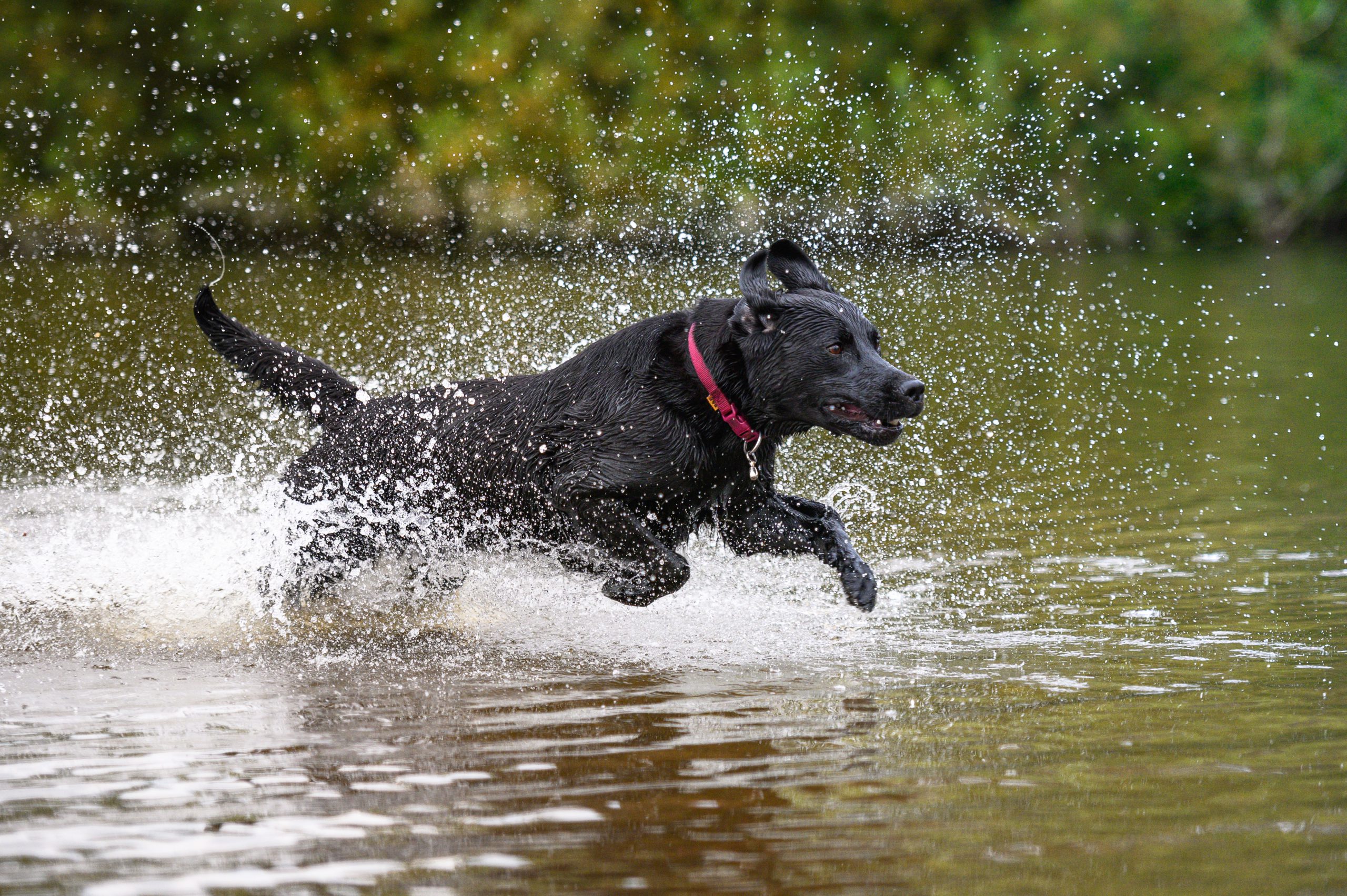Year after year, the golden retriever ranks among the top three most popular dog breeds in the U.S. and it’s not exactly hard to figure out why. Known for their friendly and people-loving personalities, goldens are as famous for being the perfect family pet as they are for their picture-perfect looks.
The typical golden is SO friendly, SO easygoing, and SO adorable that they can give the impression that they’re a “low-maintenance” dog. But, like any breed, they demand ample mental stimulation, exercise, and training. Goldens can be pretty chill compared to some breeds but most won’t be content to laze the day away on the couch.
Read on to learn the basics about golden retrievers and golden retriever mixes, and insight from owners and experts to help you live the happiest possible life with this sunny companion.
Basic golden retriever breed facts
Golden retrievers are medium-to-large sized, sturdy, and muscular in build but with broad heads, short ears, and friendly, intelligent eyes. What really makes these dogs stand out, however, is that lustrous golden coat.
As the name suggests, golden retrievers always have a golden coat, though it can range in color from a light cream-colored gold to a dark reddish gold (golden mixes, of course, can have coats with a range of other hues). Dogs of this breed often exhibit a thick ruff around the neck along with feathering on the legs, stomach, and tail. Some goldens have slightly wavy fur while others have completely straight coats.
In terms of size, golden retrievers walk the line between being a medium-sized and large breed. The average male golden stands between 23 and 24 inches tall and weighs 65 to 75 pounds. Females are a little smaller, standing up to 22.5 inches tall and weighing between 55 and 65 pounds on average.
Golden retrievers may not be the biggest of breeds, but their energy level means they require space to move around. Sweet as they are, these dogs can act up if they don’t receive enough training and exercise (and their constantly-wagging tails have been known to send things flying off coffee tables).
Golden retrievers tend not to outgrow their puppy-like personality until they are two or three years old. Some dogs may not truly start “settling down” until they are five or six. “I love the breed but one must be prepared for a very challenging first two years of puppy rearing,” says Nancy McCarty, mother of Bailey the golden.
“Treble loves everyone, so he wants to greet anyone he sees and he may try to jump on them too. We’re still working on his manners, but he’s only one-and-a-half, so he still has lots of puppy energy. Just be prepared for a dog who wants to love on everyone and every animal they see!” — Golden-mix owner Melody Atkinson
Typical golden personality profile
The golden retriever is the definition of a family dog. Friendly and outgoing, these dogs are known to make friends—both canine and human—with everyone they meet. Their bubbly personalities border on clownish.

The golden retriever can make a great family pet, as long as you don’t count “guard dog”, among their responsibilities, according to Barbara Boyd of Golden Retriever Rescue, Education, and Training (GRREAT). Your Golden may bark to alert you to an intruder, but the moment that intruder steps inside there’s a strong chance they’ll become your dog’s new best friend. While goldens are not known for being aggressive, any dog can develop aggressive behavior if they’re improperly socialized or poorly treated.
“Jesse loves everything and everybody. He always avoids conflicts. He would give up anything including a raw bone if another dog wants it. He doesn’t fight. He doesn’t get mad. He is so sweet.” – Sophia Ashley, owner of Jesse
As Boyd notes, golden retrievers are “intelligent, loving, and sometimes silly dogs who respond well to training and direction.” Many goldens love the water, and can spend a very, very long time chasing balls. “In true golden fashion, a tennis ball is never more than a paw-length away from Sullivan,” says Sully’s owner, Cait Maas. “And I mean, NEVER. He’s so ball oriented that we sometimes have to make sure we have two or three on us if we go to the park or beach just to make sure he doesn’t run after another pup’s ball to play.”
The golden retriever wants nothing more than to make you happy and to spend their days by your side. “Charlie is always up for play, wants to be included in everything and loves to be close to me at all times,” says Vanina Grovit, mom to golden retriever Charlie.
“Although Stella is 50 pounds, she acts like a lap dog. She sleeps on the bed, with her head on the pillow, underneath the covers.” — Matt Giarratano, owner of Stella
Breed history of golden retrievers
The golden retriever earned its name in part due to its golden coat, but also for its skill in retrieving waterfowl. The breed originated in Scotland where an outdoorsy type named Lord Tweedmouth began breeding them as gun dogs in the mid-1800s. At the time, they were known as the yellow retriever because they were developed as a cross between the yellow wavy-coated retriever and the Tweed water spaniel.
Breeding records indicate that Tweedmouth was aiming to breed a talented retriever with a strong nose and an attentive attitude. In addition to being a gifted gun dog, Tweedmouth also wanted the Golden to be a loyal, even-tempered companion.
The golden retriever was officially recognized as a distinct breed by the Kennel Club in England in 1911. At the time, they were simply classified as retrievers – Yellow or Golden – but the name was officially changed to golden retriever in 1920.
In 1925, the golden retriever became the 78th breed to be recognized by the American Kennel Club. The Golden Retriever Club of America was founded in 1938.
Since its recognition by the American Kennel Club, the golden retriever has been ranked among the top three most popular dog breeds in the United States. For many years, the golden ranked second only to the Labrador retriever but over the past decade or so it has dropped to third place following the German shepherd dog.
Healthy lifestyles for golden retrievers
Home environment
It’s no secret that dogs thrive on routine and this is certainly true for the golden retriever. A golden is likely to quickly adapt to your lifestyle and they will always want to be right by your side.
Like most dogs, golden retrievers are very social. They really want to be with their people. Golden retriever owners often note that their dogs follow them from room to room no matter what they’re doing. “He is the sweetest and will never leave my side when I’m home,” affirms Nicole Oanes, owner of Golden-pit mix Diablo.
Golden retrievers tend to be very gentle with children and can often get along with other household pets, including cats. Just make sure to introduce your golden to other family members slowly and monitor early interactions to ensure the safety of all involved.
You may also want to consider that all that gorgeous golden fur has to go somewhere—goldens tend to shed pretty heavily. This is a double-coated breed that sheds continuously throughout the year, though you may notice an increase in shedding in the spring and fall. “I wish I knew how much she would shed,” golden retriever owner Scott Howard says of Emma, his white-coated English cream golden. “I would have gotten all white flooring, bedding, and clothes!”
The best thing you can do to keep shedding under control is brush your dog regularly—at least once a week, or even daily if you can swing it. Use a slicker brush and a comb and work through their coat one section at a time from back to front. And though it might be tempting when temperatures soar, never shave your golden (or any double-coated dog)—the undercoat actually helps regulate temperature in both summer and winter.
Many golden owners recommend that you trim the hair around their paw pads so they don’t develop “slippers.”
Training and exercise
Goldens are well-known for their people-pleasing personalities, but dog owners who are inexperienced with the breed often underestimate the amount of exercise and training the breed requires.
“Since they’re such a social breed, they require a lot of attention and thrive around other dogs.” — Golden owner Jackie Miller
The golden retriever is an active and intelligent dog that requires a significant amount of daily exercise and mental stimulation—you should aim for at least an hour a day of walks and/or play. Lisa McGee of Golden Retrievers in Need (GRIN) Rescue cautions against golden retriever puppies and young goldens for individuals who aren’t committed to training and exercising with their dog. It’s more work than you might imagine.
“People will buy the cute little puppy with a vision of the dog lying in front of a fireplace and they end up with this active, energetic dog,” says McGee.
As young dogs especially, goldens can be particularly rambunctious. Simply put, they require a lot of attention. You need to keep their brains busy whether it’s through multiple walks a day, puzzle feeders, or obedience training (and ideally all of the above).
Courtland Palmer, says his “very active” golden-husky mix, Jake “walks twice a day, runs in fields or on the beach, and tows his dad around for 1.5 – 2.5 miles.”
Patrick Ryan, owner of a golden named Wellington agrees that a tired dog is a good dog. “Goldens are super food driven and smart. They know all the tricks to get treats out of you, but they can be managed with a consistent walk and play schedule,” he says.
“As a retriever, Welly loves to spend at least part of his walk walking himself. He’ll grab the leash gently and make sure he’s playing a part in walkies.”
Socialization and obedience training are a must for any dog, and especially an active, energetic breed like this. Whether you’re bringing home a new puppy or adopting an adult dog, start training right away and make a concerted effort with socialization during the first few weeks and months you have with your dog.
Because golden retrievers are so intelligent—and tend to be food-motivated—they typically respond very well to training and they pick up new commands quickly. They make excellent candidates for dog sports and therapy dog training.

No dog responds well to being left alone too much, but with their intensely people-oriented nature, goldens can be especially prone to separation anxiety. It’s important to start training your dog from a young age to spend time happily on their own. Don’t allow your dog to be on top of you from morning till night—getting them accustomed to hanging on their own will make it easier for both of you to spend time apart when you need to. Start out with low-intensity separation scenarios using gates, pens, and tethers, while you remain at home, with the goal of gradually increasing the intensity over time (read more about preventing separation anxiety here).
“Roman has really bad separation anxiety and will start getting really anxious the second that he cannot figure out where I am. It’s been an issue we have been working on since we got him.” — Golden owner Jarrod Thibodeau
Again, before bringing a golden home, be realistic about how much time you can really spend with them, both training and walking, and simply being together. If you spend a lot of time away from home, whether for work or travel, a golden retriever might not be the best choice of companion. If you’re looking to keep busy with a friendly, active, family-oriented companion, however, the golden might be a great fit. Some questions to consider: How many hours a day do you work away from home? Do you like going out most nights? Do you have someone, whether friend or professional dog walker, who can come in and provide exercise and company when you’re out? It’s important to think about the time and resources you have before committing to a golden retriever, or any dog.

If you’re not sure you’re ready to raise a puppy, adopting an adult or senior Golden from a rescue is a great idea. Barbara Boyd of GRREAT notes that adopting an adult dog gives you an opportunity to get to know the dog’s personality and behavior before you bring them home. Shelter dogs are typically housebroken and may already have some training under their belt.
Senior golden retrievers are a particularly good option for individuals, couples, or families looking for a calm at-home companion. A senior golden will have already outgrown its puppy-like behaviors and will be more likely to adapt well to a more sedate lifestyle, though they’ll still need to get out and walk daily.
Watch our video about Sam, the “super senior” golden who was adopted at eight and won a New York family’s hearts.
Breed-specific health concerns
Golden retrievers are a healthy breed for the most part but, like all dogs, they have predispositions to certain health issues. With a healthy diet, adequate exercise, and proper care, golden retrievers can live 12 to 14 years or more.
MANY golden owners report that their dogs have experienced digestive issues. While there are a number of causes of stomach problems, many owners report that eliminating processed food and switching to a fresh diet alleviates digestive woes.
The other health issues some goldens may be prone to include:
Ear Infections: Dogs with floppy ears can be more prone to ear infections because moisture can become trapped in the ear and become a breeding ground for bacteria. Golden retrievers typically develop outer ear infections which may result in redness, itching, and odorous discharge. If left untreated, outer ear infections can spread into the middle or inner ear which could affect your dog’s hearing. Be sure to keep water out of your dog’s ears while bathing. Put cotton balls in their ears during bath time to prevent water from getting in–just remember to take them out after! If your dog spends a lot of time swimming, try to clean their their ears frequently (more here on how to safely clean their ears).
Chronic ear infections are also a common secondary sign of allergies in dogs. Signs to look out for include frequent head shaking, scratching at the ears or rubbing the face on carpet, and discharge and/or an odor coming from the ear canal. Speak to your vet if you see these behaviors.
Cancer: It is an unfortunate fact that goldens are more predisposed to cancer than most other breeds—roughly 60% of all golden retrievers will die from some form of the disease. Some of the most common cancers seen in golden retrievers include hemangiosarcoma (cancer of the blood vessels often found in the heart and spleen), osteosarcoma (bone cancer), lymphoma (cancer of specific immune cells), and mast cell tumors. Genes are most frequently cited as a likely contributor, but there are many environmental factors that might contribute to this sad predisposition. In fact, the breed’s propensity for cancer has inspired a massive longitudinal study in the U.S.—The Golden Retriever Lifetime Study. Researchers are gathering data on 3,000 dogs, covering everything from genes to diet and environmental pollutants to determine the cancer risk factors for goldens (and, by extension, other dogs). There’s no sure way to eliminate the risk, but you can give your golden the best chance at staying healthy by doing everything you can to reduce inflammation and promote a healthy diet. That includes keeping them at a healthy, lean, weight, and avoiding heavily processed foods that contain preservatives and possibly other carcinogens. Some research involving Scottish terriers has linked increased vegetable consumption to a lower risk of an insidious form of cancer in that breed. Kibble and canned food just can’t supply fresh, whole vegetables like a fresh diet can.
Joint Dysplasia: Hip dysplasia and elbow dysplasia are fairly common in golden retrievers and both can lead to changes in gait and even lameness. Hip dysplasia is a heritable condition characterized by anatomic abnormalities which prevent the thighbone from fitting snugly into the hip joint. Elbow dysplasia, also a heritable condition, is characterized by laxity in the elbow joint which can lead to lameness. Golden retrievers are also prone to osteochondrosis (OCD) which can cause secondary arthritis. OCD is a condition that affects young large-breed rapidly growing dogs. It’s linked to over-feeding and excess dietary calcium and protein, so it’s important to feed puppies a balanced and high-quality diet. Keeping your dog at a lean, healthy weight, and feeding fresh, complete and balanced food that provides the right amount and proportion of Omega-3 fatty acids can help guard against inflammation and protect your dog’s joints.
Skin Allergies: Dogs can develop allergies to a wide variety of things ranging from fleas and other external parasites to food, pollen, mold, and other environmental irritants. Skin allergies typically present with redness, itching, and hair loss. If your dog seems to be scratching more than usual or if he starts obsessively licking his paws or rubbing his face, you may want to check in with your veterinarian.
Hypothyroidism: Characterized by an underactive thyroid gland, hypothyroidism is a common endocrine disorder in dogs like the golden retriever. This condition can cause changes in weight or appetite, low energy, and changes in skin and coat.
Cataracts: A cataract is a cloudy spot that develops on the lens of the eye. Cataracts are most commonly inherited, but other causes and risk factors include diabetes mellitus, abnormally low levels of calcium, exposure to radiation or toxic substances, and age. Cataracts can develop at any age but are most common in older golden retrievers. The cataract may not impair the dog’s vision at first but over time, it may prevent light from reaching the retina which may cause blindness. Be sure to have your golden’s eyes checked regularly and report any cloudiness in their eyes.
Bloat: Gastric dilation volvulus or bloat is a common condition in large and deep-chested breeds. Bloat occurs when the stomach becomes filled with air or gas then twists on its axis, cutting off blood flow. This results in a sudden drop in blood pressure which can cause the dog to go into shock. If left untreated, this condition can become fatal.
The best way to prevent bloat in golden retrievers is to keep your dog from eating too quickly or too much at once. You can do this by breaking your dog’s daily feeding into smaller meals rather than one large meal. It may also be a good idea to use a slow-feeder food bowl that prevents your dog from inhaling all their food too quickly, and a smaller water bowl that you refill often instead of a large bowl to prevent your dog from drinking too much water at once, especially before or after meals.

Nutrition for golden retrievers
These are some best practices for feeding your golden retriever to help maintain a healthy weight, reduce digestion problems, and help protect joints.
Maintain a healthy weight
It’s critically important to avoid overfeeding your golden because this breed is prone to obesity.
It can’t be emphasized enough: being overweight isn’t simply a cosmetic issue for dogs. It’s a health hazard as it’s linked to a raft of diseases including cancer. Veterinary experts say being even slightly overweight can cause health problems. As Dr. Carol Osborne, an integrative veterinarian at Chagrin Falls Pet Clinic in Ohio, told us, “being just 10% overweight decreases a dog’s lifespan by one-third and predisposes him to heart, kidney and liver disease as well as diabetes, arthritis and cancer.”
Mind the treats
Goldens are all about food, so it’s important to maintain some dietary guard rails. Avoid sharing food from the table with your pup. Even though many “human” foods are fine for dogs to eat, some aren’t, and they can be the source of digestive distress that can be unpleasant for both of you. Sharing your food with your pet can make it hard to ensure correct nutrient ratios and calories per day, and can encourage unwelcome intrusions on your own mealtime.
Keep treats special, and useful as training incentives, by not overfeeding them. Keep extras to no more than 10% of daily calories, and lean to single-ingredient options like veggies and the occasional fruit.
Feed for healthy growth
Another concern is rapid growth in puppies. Golden retriever puppies tend to grow very quickly and, while this is normal, it’s important to prevent your puppy from growing too fast. Rapid growth can put strain on your puppy’s bones and joints which may predispose them to musculoskeletal issues in adulthood. For this reason, it’s best to follow feeding recommendations for your puppy’s age and size, offering controlled portions rather than allowing your puppy to feed freely. High-quality, balanced food is especially important for your growing puppy .
Prevent and manage allergies
For goldens with dry and itchy skin, sensitive stomachs, or other signs of food allergies and sensitivities, it’s important to know exactly what you’re feeding, something that can be impossible with kibble, which often contains ingredients not listed on the bag. Allergic reactions and intolerances to food are all too common in dogs and some dog owners notice symptoms clear up when they switch to fresh food.
Healthy fats for a glorious coat
Nutrition has a huge impact on the health and appearance of your golden’s golden coat.
When a dog’s diet is missing something important–like digestible protein, fats, moisture, and sufficient nutrients in the right balance–it manifests in a variety of ways, from dry skin and a dull coat to patches of hair loss. “Dry skin and hair coat can be due to a nutritional issue, allergies, or a medical condition,” Dr. Gary Richter, DVM has told us. “Conversion to a fresh, whole food diet frequently improves skin and coat.”
Healthy fats are an important ingredient for overall health, and skin and coat health. Omega-3s help to reduce inflammation, while Omega-6s increase inflammation, which plays a role in immunity, and cell growth. A healthy balance of these two essential fatty acids provides a range of health benefits including a lustrous coat. If you’re feeding kibble, which tends to be higher in Omega-6 acids, your dog might have an imbalance which may contribute to chronic inflammation.
If you’re feeding a fresh, balanced food, you shouldn’t need to add extra Omega-3 supplements to achieve a shiny, healthy coat. However, if you want a boost of healthy fats for coat, and overall health, whole sardines are a great source, and a great snack, in moderation.
In sum, if you’re looking for a healthy and nutritious option for your golden, consider fresh food. Feeding fresh dog food made from human-grade meat and vegetables is the best way to be sure of exactly what you’re putting in your dog’s bowl. Because it’s lightly cooked, it delivers all the powerful nutrients contained in those ingredients. The food comes pre-portioned according to your dog’s unique caloric needs so it’s easy to manage your dog’s weight, and to change their daily caloric intake as their needs change.
“I started Emma on an all natural diet from day 1, but she has always had a sensitive stomach and quickly lost interest in food. I tried raw and she couldn’t tolerate it. I gave her salmon, sardines, grass-fed beef, probiotics, etc., but always the same result. Frustrated and tired of cooking, I tried The Farmer’s Dog, and after more than a year she is still excited to eat and rarely has stomach issues.” — Golden owner Scott Howard
If you’re thinking about bringing a golden retriever into your life, stop into your local animal shelter or look for a breed-specific rescue near you. And be sure to broaden your search to include golden mixes, who will provide every bit of the sweetness you’re looking for in a canine companion. Potential adopters in Ohio, Pennsylvania, and New York should check out adoptable Goldens available at GRIN Rescue in Cleveland, OH, or Sunshine Golden Rescue, based in New York state.
Read more breed guides:




